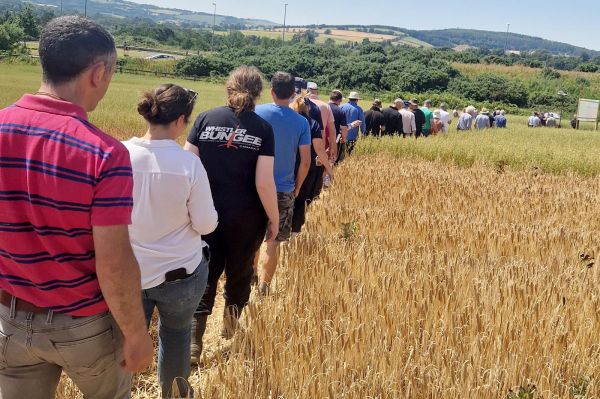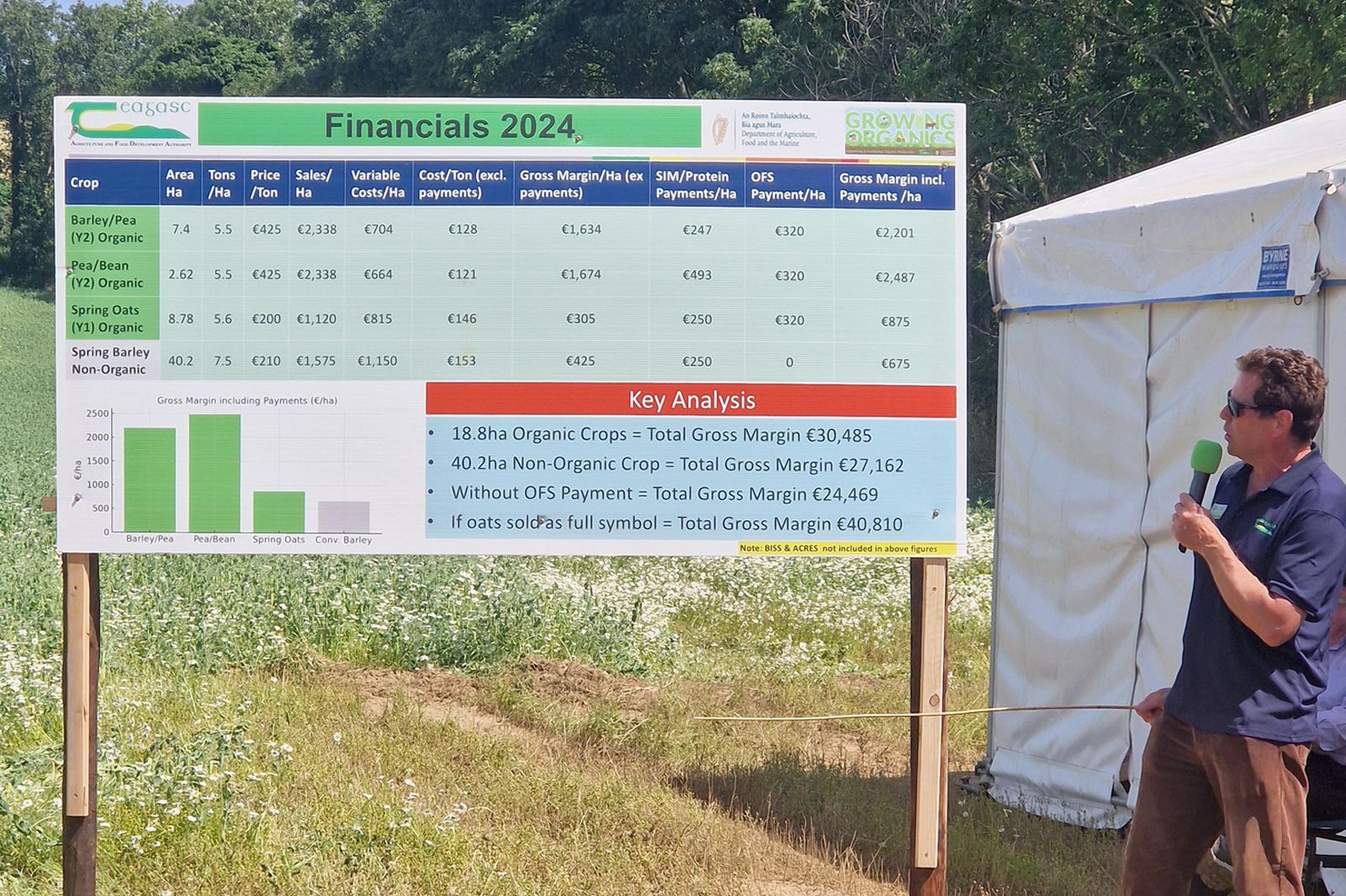'Huge demand, little supply'

On a sweltering summer’s day, on the farm of Tommy Delahunt, the supply and demand imbalance for organic cereals was highlighted. Niall Ryan was present from the Department of Agriculture, Food and the Marine (DAFM), and he outlined a significant deficit, which presents great opportunities for tillage farmers thinking about conversion.
“We have a deficit of 30,000t this year and they will have to come from somewhere,” he said. “There is great opportunity there. There is huge demand and very little supply, so that is a win-win.”
Several years ago, Tommy Delahunt recognised that opportunity and followed through with partial conversion, and he has been making great progress in a short timeframe. Initially, 17 hectares (ha) of land on his east Wicklow farm went to organics, which has increased to 31.15ha currently – he operates non-organically, also. He grows a range of organic crops, showcased at the farm walk such as winter and spring cereals, a barley/pea intercrop (combi-crop), as well as multispecies grass sward.
Tommy’s organic oats are grown on contract to Flahavan’s and the pea/barley intercrop is for the feed market, and sold on contract to another farmer. One of the highlights of the walk was learning about Tommy’s profitable pea/bean intercrop, the growing of which is a relatively new concept, according to Teagasc.
GROWING Organics Programme
Tommy is one of 13 participant farmers in Teagasc’s Growing Organics programme, which is funded by the Department of Agriculture, Food and Marine. According to Teagasc this is a five-year monitor-farm initiative aimed at supporting and showcasing best practices in organic farming. A key feature of the programme on Tommy’s farm is the trialling of protein crops for the organic animal feed market. In 2024, Tommy achieved a yield of 5.5 tonnes per hectare (t/ha) from his pea/bean intercrop, which was sold to an organic dairy farmer.
Pea priority
Tommy’s farm is also one of three organic farms involved in the Valpro Path trial, which focuses on growing high-yielding protein crops across Ireland, Italy, Germany, Denmark and Portugal. In Ireland, Teagasc researchers are focusing on intercropping peas with fava beans to help prevent pre-harvest lodging that peas are prone to.
Organic tillage specialist with Teagasc, Martin Bourke, was present and explained more: “The objective of this [trial] is to look at the amount of peas sown in the country. Peas are seen as having tremendous value but, traditionally, peas lodge and one of the things they are looking at [in the trial] is growing them with a scaffolding crop that acts as a support for it. Beans in this particular situation provide that scaffold, and is just a secondary crop."
“From the organic side of things, we see the potential in growing peas as an animal feed for the livestock farmer. We like peas because they are like our ‘herbicide’ – peas smother the weeds, so they are like a herbicide even though there is nothing chemical about them," said Martin..
Under the Valpro trial, a certain ratio of pea to bean is being used and the trial on Tommy’s farm has a ratio of 70 per cent pea and 30 per cent bean. “Based on results, they think that 30 per cent bean is correct,” said Martin. “But there were harvesting difficulties last year when the pea grew too tall for the bean to support it. The pea lodged and it was very difficult to harvest it.” This was believed to have been connected to the the total seed rate, which was too much. This year, they are trialing fewer seeds overall, but keeping the ratio of 70 per cent pea and 30 per cent bean." At the farm walk, there was a notable difference in the height of the 100 per cent pea crop, which was shorter than the pea/bean intercrop.

Organic tillage specialist with Teagasc, Martin Bourke, details the profitability of Tommy’s farm.
Protein profitability
Outlining the profitability of Tommy’s enterprise in 2024, Martin commented that the figures are extremely attractive. Last year was year number two of conversion for Tommy’s intercrops and his pea/bean intercrop performed very well. It yielded 5.5t/ha, commanded €425/t, and its gross margin was €1,674/ha. The barley/pea intercrop performed similarly in terms of yield and price/t but its gross margin was slightly less, at €1,634.
However, the protein payment was greatly enhanced for the pea/bean crop because it is a 100 per cent protein crop, so Tommy received the full rate of payment of €493/ha. He also received €320/ha under the Organic Farming Scheme.
For his barley/pea intercrop, which comprised 70 per cent pea and 30 per cent barley, he received €247/ha under the protein aid scheme, as well as €320/ha under the Organic Farming Scheme.
“You make your own luck – but this is not just luck,” Martin said of the barley/pea crop. “This is a very good crop, and that is why it fetched €425. Tommy managed to look after the crop, and the peas really well, to make sure he had a high protein crop, which is particularly important for dairy farmers. That all comes back to good management.”
Non-organic comparison
The performance of a non-organic crop was detailed on the day also. Just over 40ha of conventional spring barley was grown by Tommy in 2024, yielding €210/t. Variable costs here were €1,150/ha, which, Martin said was competitive, compared to an expected cost of €1,289 for conventional spring barley. Tommy’s was less because he replaced some of his chemical fertiliser with poultry manure. The gross margin per hectare for this crop was €425/ha, added to the straw incorporation payment of €250/ha, which brought it to €675/ha.
There is one message to take from this, Martin said: “Tommy is growing nearly two acres of a conventional crop to give him the same margin as one acre of organic. The figures are extremely attractive.”
Systems changes
Since converting to organic tillage farming, there have been a number of systems changes on Tommy’s farm:
- Introduction of intercropping.
- Growing organic feed on
contract to other farmers – 10.5ha. - Growing organic oats on
contract to Flahavans – 13.48ha. - Experimenting with trials on: mechanical weeding; seeding rate and ratios of cereal/legume; sowing dates; organic maize; optimising use of poultry manure pellets




